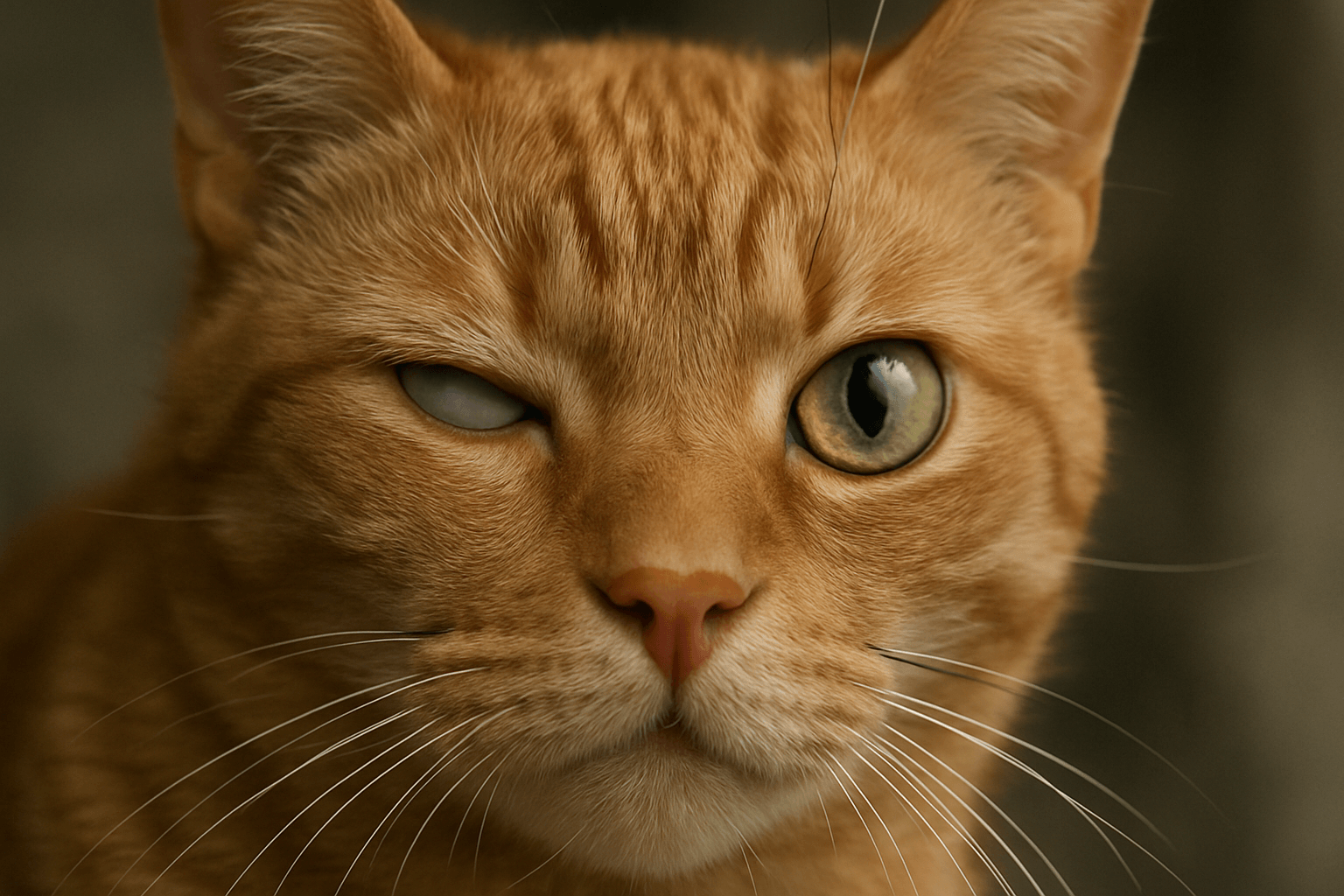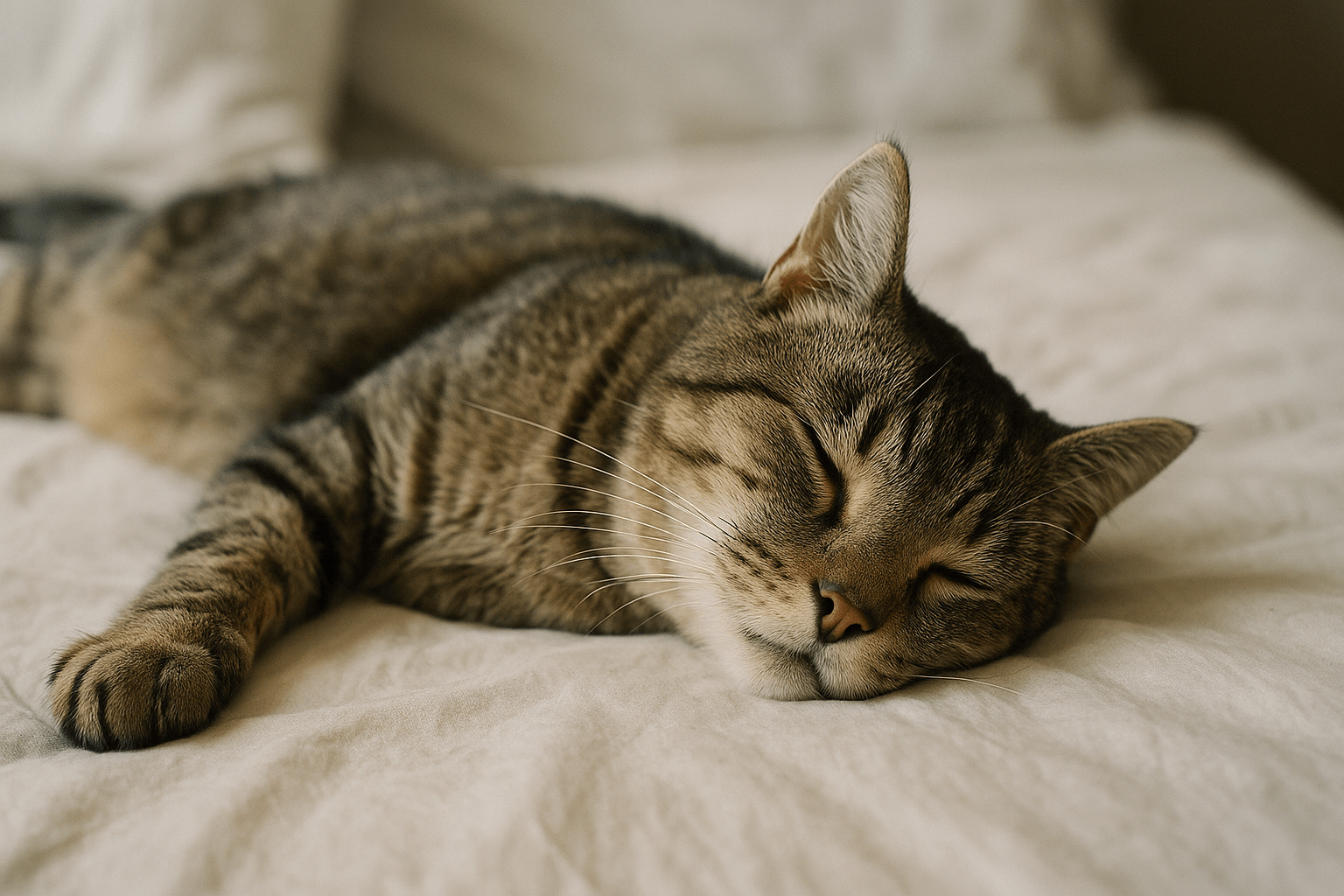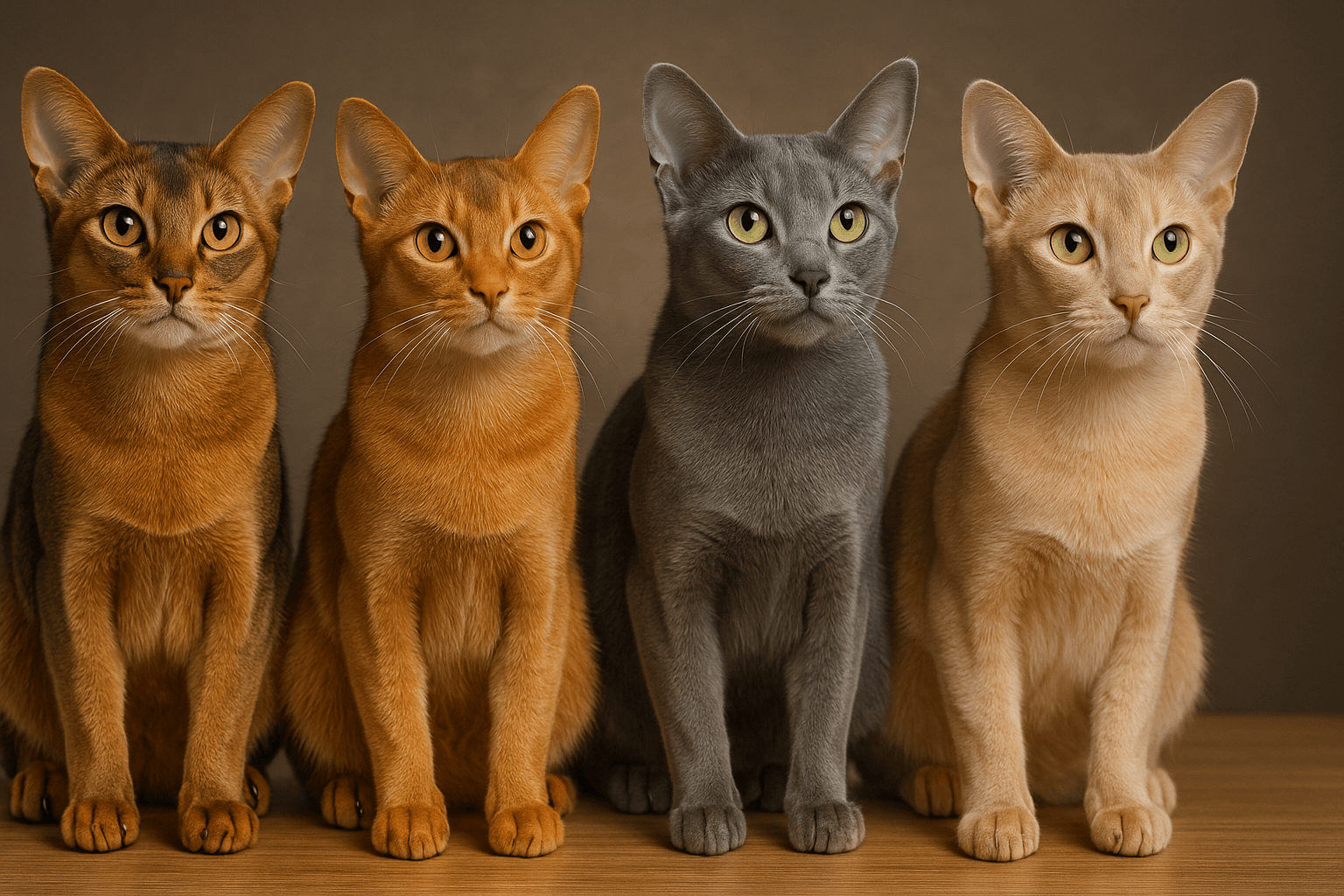Dwarf Cat Lifespan: Best 7 Expert Tips!
Dwarf cats, often characterized by their uniquely short legs, capture hearts with their adorable appearance and charming personalities. Many prospective owners, captivated by their distinct features, often wonder about the dwarf cat lifespan. Is it different from that of a standard feline? What special considerations come with owning these petite pusses?
Defining “Dwarf Cat”: More Than Just Short Legs
Before we dive into the specifics of the dwarf cat lifespan, it’s crucial to understand what exactly constitutes a “dwarf cat.” The term is often used broadly, but scientifically, it refers to felines affected by a genetic condition called chondrodysplasia. This condition specifically impacts the development of cartilage, leading to shortened limbs while the body remains of typical size. It’s this unique genetic trait that gives them their distinctive appearance.
Here’s a closer look at what defines a dwarf cat:
Chondrodysplasia: This is the core genetic condition responsible for the short legs. It’s a form of skeletal dysplasia characterized by disproportionate dwarfism, meaning the limbs are affected, but the head and torso are generally normal-sized.
Specific Breeds: While any cat could theoretically be born with a spontaneous mutation causing dwarfism, recognized dwarf cat breeds have been intentionally developed through selective breeding to perpetuate this trait. The most famous example is the Munchkin cat, which is the foundational breed for many other dwarf cat variations.
Distinct Physical Traits: Beyond short legs, dwarf cats typically have a normal-sized body and head, giving them a rather unique, elongated appearance. Their short limbs affect their jumping ability and overall mobility compared to non-dwarf cats.
Genetic Inheritance: The gene responsible for chondrodysplasia in Munchkin cats (and many other dwarf breeds derived from them) is an autosomal dominant gene. This means only one copy of the gene is needed for a cat to express the dwarf trait. However, having two copies of the gene is often lethal to embryos, making responsible breeding critical.
Not a Health Condition, but a Trait: While chondrodysplasia is a genetic condition, it’s generally considered a physical trait in recognized dwarf breeds, similar to a specific coat color or ear shape, rather than an inherent illness that shortens their life, assuming responsible breeding practices are followed.
Understanding these foundational aspects helps us approach the topic of their lifespan with accurate information, separating myth from reality.
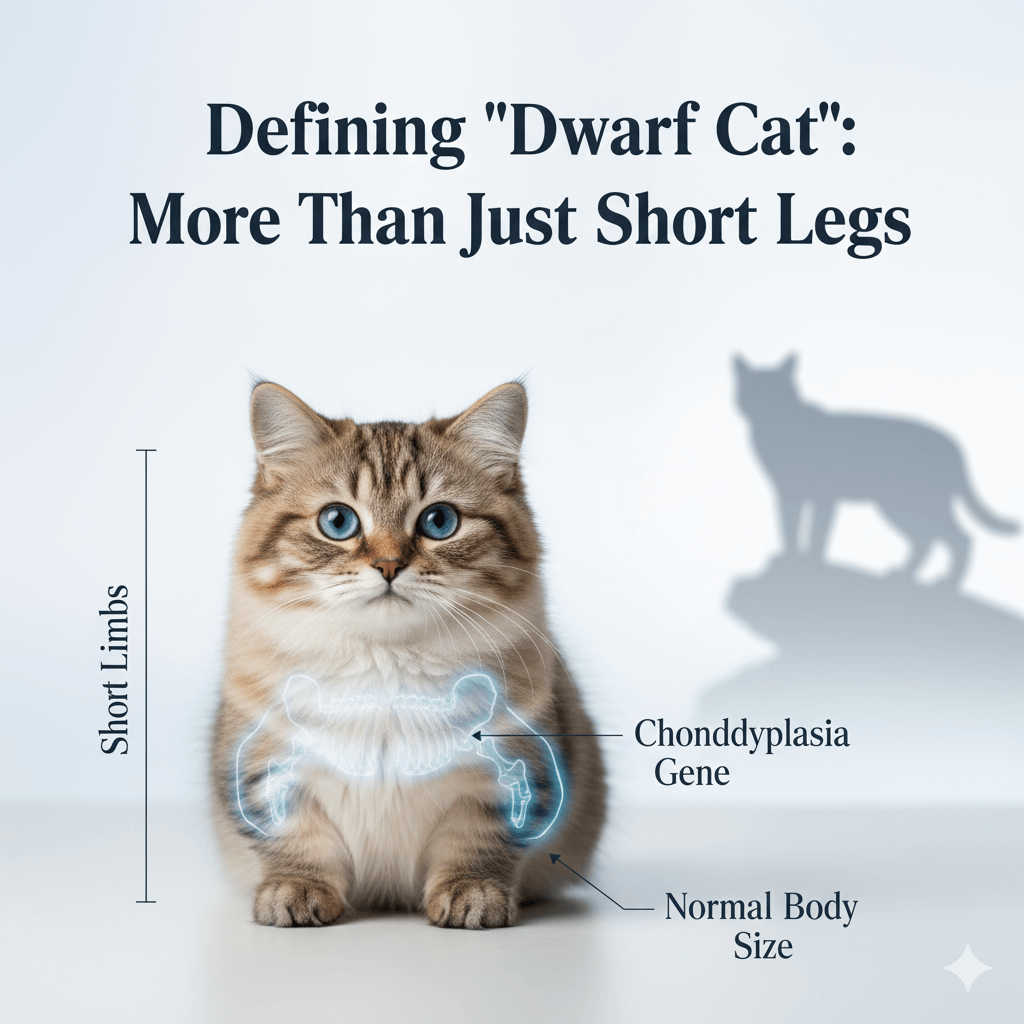
Factors Influencing the Dwarf Cat Lifespan: Genetics vs. Care
When examining the dwarf cat lifespan, it’s essential to consider a multitude of factors, much like with any other domestic cat. While their unique genetics might raise some questions, it’s often daily care, environment, and overall health management that play the most significant roles in how long and how well these charming felines live. The dwarf trait itself is not typically a direct cause of a shortened life, but potential associated conditions or specific care requirements can influence longevity.
Let’s break down the key factors:
Genetic Health (Beyond Dwarfism): While chondrodysplasia itself doesn’t inherently shorten their life, irresponsible breeding practices can introduce other genetic predispositions to health issues. Reputable breeders screen for common feline diseases (like hypertrophic cardiomyopathy or polycystic kidney disease) to ensure the overall genetic health of their lines.
Nutrition: A balanced, high-quality diet appropriate for their age, activity level, and any specific dietary needs is paramount. Proper nutrition supports organ function, maintains a healthy weight, and strengthens the immune system, all vital for a long dwarf cat lifespan. Overfeeding can lead to obesity, which exacerbates any potential orthopedic issues from their short legs.
Veterinary Care: Regular check-ups, vaccinations, parasite control, and prompt attention to any signs of illness are critical. Early detection and treatment of health problems can significantly extend a cat’s life. Dwarf cats might benefit from vets experienced with their specific physical structure.
Environment and Safety: A safe indoor environment free from hazards is crucial. For dwarf cats, this also means considering their limited jumping ability. While they are agile, falls from high places could be more problematic due to their unique skeletal structure. Enrichment (toys, scratching posts, cat trees with ramps) is also important for mental and physical well-being.
Weight Management: Due to their short legs, dwarf cats might experience more strain on their joints and spine if they become overweight. Maintaining an ideal body condition is especially important to prevent or alleviate orthopedic issues, which could otherwise impact their comfort and longevity.
Spaying/Neutering: Unless intended for breeding, spaying or neutering can significantly improve a cat’s health and increase its dwarf cat lifespan by reducing the risk of certain cancers, behavioral problems, and accidental injuries associated with roaming or fighting.
Mental Stimulation and Love: Cats thrive on interaction, play, and a stable, loving environment. Stress and boredom can negatively impact a cat’s immune system and overall health. A happy cat is often a healthier cat.
By focusing on these controllable factors, owners can maximize their dwarf cat’s potential for a long and vibrant life.
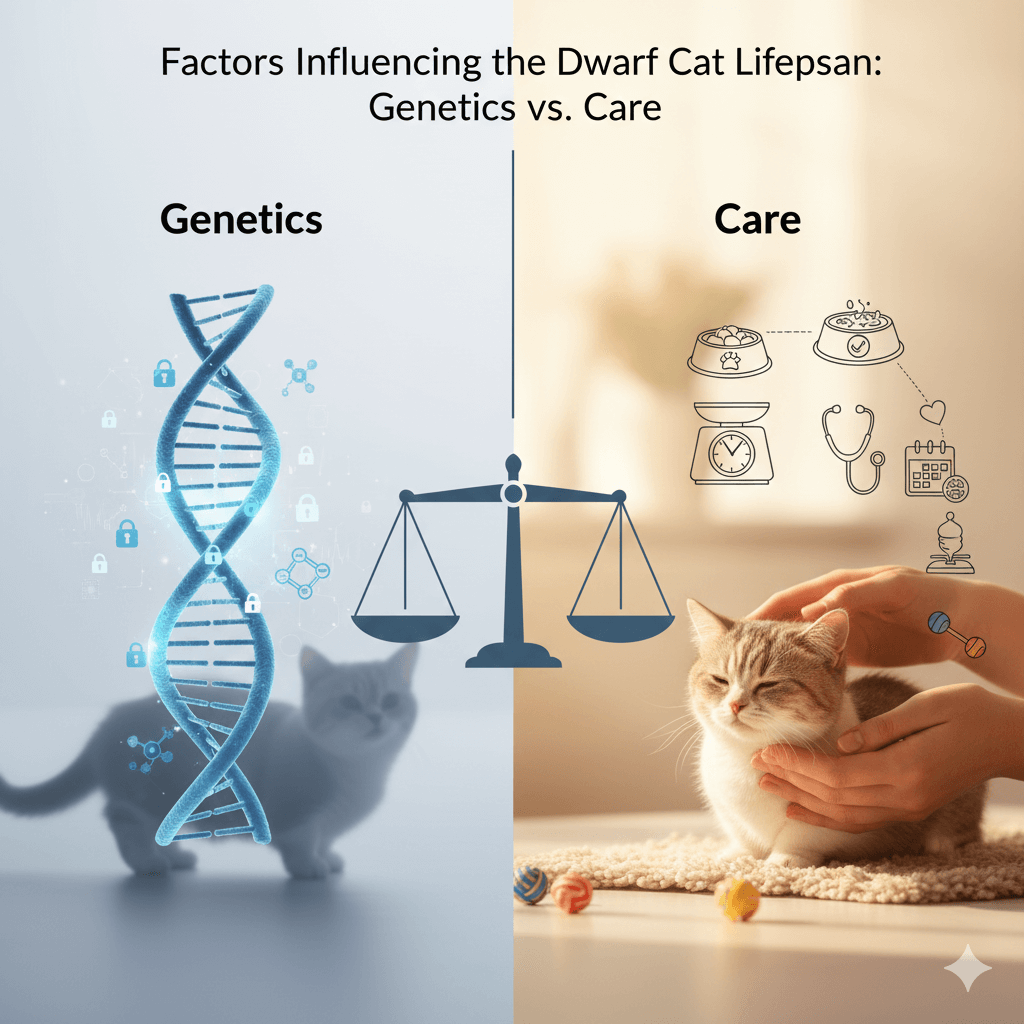
Check this guide 👉Understanding Dwarf Syndrome in Cats: Best 7 Expert Tips!
Check this guide 👉Turkish Van Cat Lifespan: Best 7 Expert Tips!
Check this guide 👉British Shorthair Cat Lifespan: Best 7 Expert Tips!
| Health Risk | Impact on Lifespan |
|---|---|
| Osteoarthritis and joint pain | Chronic pain reduces mobility, increases stress, and accelerates decline if untreated. |
| Lordosis (spinal curvature) | Can compress organs or nerves, leading to respiratory or neurological complications. |
| Obesity | Excess weight strains already compromised joints, increasing risk of diabetes and heart disease. |
| Dental crowding | Poor oral health leads to systemic infections that shorten life expectancy. |
| Limited mobility leading to inactivity | Reduces muscle mass, increases depression, and accelerates age-related decline. |
Common Health Considerations for Dwarf Cats: What to Watch For
While the dwarf cat lifespan is generally comparable to that of other domestic cats, their unique physical structure does bring a few specific health considerations into focus. It’s important for owners to be aware of these potential issues so they can provide proactive care and address any concerns promptly with their veterinarian. Being informed allows you to distinguish between typical dwarf cat traits and actual health problems.
Here are some common health considerations specific to dwarf cats:
Orthopedic Issues: The primary concern related to their chondrodysplasia is the potential for orthopedic problems. While many dwarf cats live without severe issues, their shortened, sometimes bowed, limbs can put extra strain on joints. Conditions like osteoarthritis, patellar luxation (dislocating kneecaps), or even spinal lordosis (excessive inward curvature of the spine) have been observed, though not universally.
Weight Management Challenges: As mentioned, their short legs mean they carry weight closer to the ground, and excessive weight can put significant stress on their spine and joints. Obesity can exacerbate any existing orthopedic predispositions and impact their mobility and quality of life.
Dental Health: This is a common issue for all cats, but some dwarf breeds, especially those with brachycephalic (short-nosed) features if combined with dwarfism, might have more crowded teeth, leading to a higher risk of dental disease. Regular dental check-ups and at-home care are crucial.
Breed-Specific Concerns: Depending on the specific dwarf breed (e.g., Munchkin, Minuet/Napoleon, Bambino), there might be other breed-specific genetic predispositions. For example, some purebred cats (dwarf or not) can be prone to hypertrophic cardiomyopathy (a heart condition) or polycystic kidney disease. Responsible breeders will screen for these.
Mobility Limitations: While most dwarf cats adapt incredibly well to their short legs and are surprisingly agile, their ability to jump to high places is limited. Owners should provide ramps or steps to assist them, especially to furniture, to prevent falls or strain.
Grooming: For long-haired dwarf breeds, or those with unique coat types (like the Sphynx-derived Bambino, which is hairless), specific grooming needs arise. Ensuring their coat/skin is well-maintained prevents discomfort and skin issues.
It’s vital to remember that having short legs does not automatically mean a dwarf cat will suffer from all these conditions. Many live long, healthy lives with no more health issues than an average cat. However, awareness allows for better preventative care and quicker intervention if problems arise, contributing positively to the dwarf cat lifespan.

Average Dwarf Cat Lifespan: The Numbers and the Reality
One of the most pressing questions for prospective owners is, “What is the average dwarf cat lifespan?” The good news is that for well-cared-for dwarf cats from reputable breeders, their life expectancy is generally comparable to that of other domestic cats, often ranging from 12 to 15 years, with many individuals living even longer. The unique chondrodysplasia gene itself is not linked to a reduced lifespan, provided the cat is otherwise healthy and well-managed.
Here’s a breakdown of what contributes to these numbers:
Comparable to Non-Dwarf Cats: Healthy dwarf cats, particularly breeds like the Munchkin, are often reported to have a lifespan similar to mixed-breed cats or other purebred felines, which typically fall within the 12-15 year range. Some even live into their late teens or early twenties.
Impact of Breeding Practices: The key differentiator for a long dwarf cat lifespan is often the breeding practices. Cats from backyard breeders or kitten mills, which may not screen for genetic diseases or practice ethical breeding, are at a higher risk of inherited health problems that could shorten their lives.
Individual Variation: Just like humans, every cat is an individual. Factors such as genetics, nutrition, environment, and veterinary care play a huge role. Some cats are simply more robust than others, regardless of breed or specific traits.
Management of Predispositions: As discussed, dwarf cats can be predisposed to certain orthopedic issues. If these conditions are properly managed through diet, weight control, and veterinary intervention (e.g., pain management, physical therapy), they typically do not shorten the cat’s life but rather impact its quality of life if left unaddressed.
Preventative Care: Consistent preventative veterinary care (vaccinations, parasite control, annual check-ups) is a universal factor in extending any cat’s life, and dwarf cats are no exception. Early detection of any health anomalies is crucial.
Environment: Indoor-only cats generally live longer than outdoor cats due to reduced exposure to accidents, predators, and infectious diseases. This applies equally to the dwarf cat lifespan.
In summary, a dwarf cat’s short legs do not automatically condemn them to a shorter life. With attentive care, responsible breeding, and a focus on overall health, these charming felines can enjoy a long and fulfilling life as cherished members of your family.

Ensuring a Long and Happy Dwarf Cat Lifespan: Owner’s Guide
As a proud owner or prospective owner of a dwarf cat, your dedication to their well-being is the single most important factor in maximizing their dwarf cat lifespan and ensuring their happiness. While their unique physique requires a little extra thought, providing a loving, safe, and stimulating environment tailored to their needs can lead to many joyful years together. It’s all about proactive care and understanding their specific requirements.
Here’s an owner’s guide to promoting longevity and quality of life:
Prioritize a Balanced Diet: Choose a high-quality cat food appropriate for their age and activity level. Pay close attention to portion control to prevent obesity, which is particularly detrimental to dwarf cats’ joints and spine. Consult your vet for dietary recommendations.
Regular Veterinary Check-ups: Schedule annual wellness exams. These check-ups are vital for early detection of potential health issues, including dental problems, heart conditions, and any signs of arthritis. Discuss any changes in mobility or behavior with your vet.
Maintain an Ideal Weight: This cannot be stressed enough for dwarf cats. Their short legs mean extra weight puts undue stress on their skeletal system. Work with your vet to establish and maintain an optimal weight range through diet and appropriate exercise.
Create a Safe and Accessible Environment: While dwarf cats are agile, they can’t jump as high as other cats. Provide ramps or pet stairs for easy access to favorite perches, beds, and furniture. Secure any unstable furniture they might try to climb.
Encourage Gentle Exercise: Engage them in regular, appropriate play. Laser pointers, feather wands, and toys they can chase on the ground are great for mental stimulation and physical activity without overstraining their joints.
Consistent Grooming: Regular brushing (especially for long-haired varieties) prevents matting. For hairless breeds like the Bambino, regular skin care is essential to prevent dryness or irritation. Keep their nails trimmed to prevent snags and discomfort.
Dental Hygiene: Implement a dental care routine, which can include regular tooth brushing, dental treats, or professional dental cleanings as recommended by your vet. This is crucial for overall health and can impact their dwarf cat lifespan.
Plenty of Love and Enrichment: Dwarf cats are known for their playful and affectionate personalities. Provide ample attention, cuddles, interactive play, and a stimulating environment with toys and safe spaces. A happy cat is a healthy cat.
By consistently applying these tips, you’re not just ensuring your dwarf cat’s longevity but also enhancing their overall quality of life, allowing them to thrive and bring joy to your home for many years.
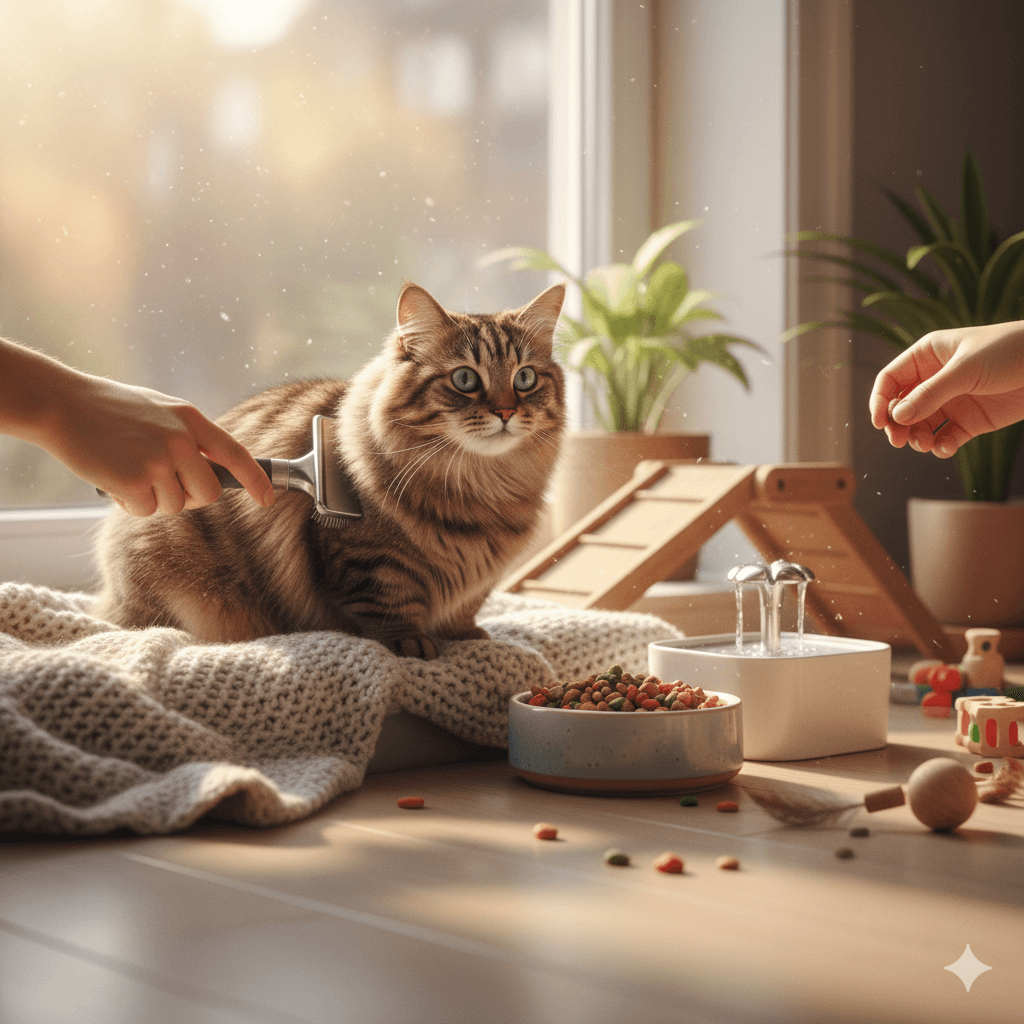
Responsible Breeding and the Dwarf Cat Lifespan: What Prospective Owners Should Know
When considering bringing a dwarf cat into your home, understanding the role of responsible breeding is absolutely paramount, especially concerning the dwarf cat lifespan and long-term health. The unique genetic trait of dwarfism means that ethical breeding practices are not just a preference, but a necessity to prevent potential health complications and ensure the well-being of these special felines. Choosing a reputable breeder is the single most important step a prospective owner can take.
Here’s why responsible breeding matters for a healthy dwarf cat:
Minimizing Genetic Health Risks: A reputable breeder will carefully screen their breeding cats for common genetic diseases that can affect any cat breed, such as hypertrophic cardiomyopathy (HCM) or polycystic kidney disease (PKD). This is crucial to prevent passing on such conditions, which could significantly impact the dwarf cat lifespan.
Avoiding Lethal Alleles: For breeds like the Munchkin, the gene for short legs is dominant. Breeding two cats with the dwarf gene carries a risk, as kittens inheriting two copies of the dominant gene often do not survive gestation. Responsible breeders will typically breed a dwarf cat with a non-dwarf cat to produce a healthy litter with both short-legged and long-legged offspring.
Focus on Health and Temperament: Ethical breeders prioritize the overall health, structure, and temperament of their cats, not just their physical appearance. They aim for robust, well-adjusted kittens, ensuring they are free from debilitating structural problems that could arise from poor breeding.
Transparency and Support: A good breeder will be transparent about their breeding practices, health testing results, and the health history of their kittens’ parents. They will also provide ongoing support and advice to new owners, acting as a valuable resource throughout the cat’s life.
Proper Socialization: Responsible breeders ensure their kittens are well-socialized from an early age, which is vital for developing a confident and friendly temperament. This contributes to a happy cat, which in turn can contribute to a healthier dwarf cat lifespan.
Education for Buyers: They educate prospective owners about the specific needs and potential health considerations of dwarf cats, preparing them for responsible pet ownership.
By choosing a breeder who demonstrates a strong commitment to health, ethics, and the welfare of their animals, you are making a significant investment in the future health and longevity of your dwarf cat. This diligent approach helps ensure that your new family member will enjoy a full and healthy dwarf cat lifespan.
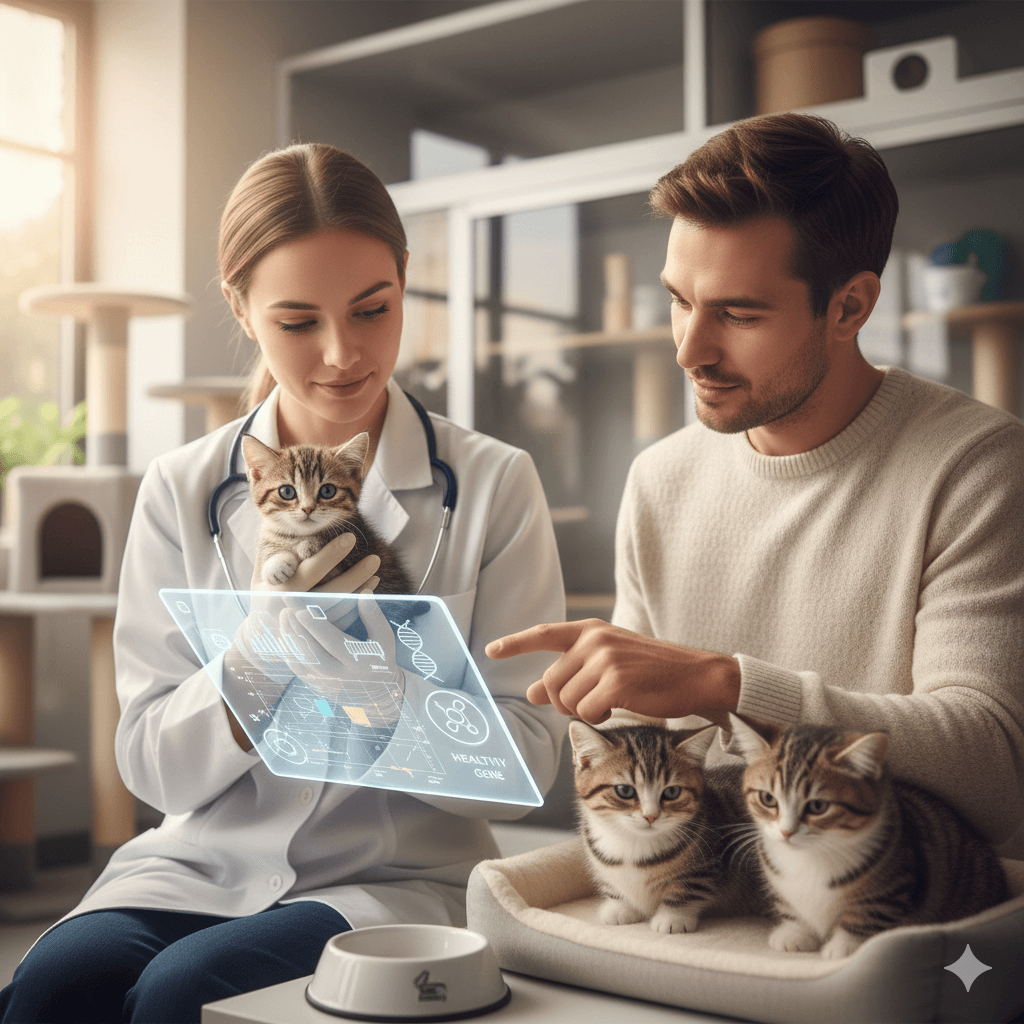
The Joys of Living with a Dwarf Cat: Personality and Adaptability
Beyond the important considerations of the dwarf cat lifespan and health, it’s equally important to appreciate the wonderful personalities and adaptability that these unique felines bring into a home. Dwarf cats are not just their short legs; they are often described as playful, intelligent, affectionate, and incredibly endearing companions. Their physical uniqueness does not hinder their ability to live full, happy, and engaging lives.
Here’s what makes living with a dwarf cat such a joy:
Playful and Energetic: Despite their shorter limbs, dwarf cats are often surprisingly active and curious. They love to play, chase toys, and explore their surroundings. Their playful nature can bring endless entertainment and laughter to a household.
Affectionate and Cuddly: Many dwarf cat owners report that their cats are very affectionate and enjoy cuddling. They often form strong bonds with their human companions and love to be close, purring contentedly on laps or next to their owners.
Intelligent and Curious: Dwarf cats are intelligent and enjoy mental stimulation. Puzzle toys, interactive games, and even learning simple tricks can keep their minds sharp and engaged, contributing to their overall well-being.
Adaptable and Resilient: These cats are incredibly adaptable to their environment. They quickly learn to navigate their surroundings, often finding creative ways to reach desired spots, even if it means using furniture as stepping stones or ramps.
Good with Other Pets and Children: With proper introductions, dwarf cats generally get along well with other pets and respectful children. Their gentle and playful nature makes them a wonderful addition to many family dynamics.
Unique “Ferret-Like” Movement: Their distinctive gait, sometimes described as “ferret-like” due to their low-to-the-ground posture and agile movement, adds to their charm and uniqueness. They might not jump vertically as high, but they can be incredibly fast across the floor.
Easy to Entertain: Their love for ground-level play means they are often easily entertained with simple toys, string, or even just a crumple of paper. This makes them a joy to interact with daily.
Embracing the special qualities of a dwarf cat means not only tending to their physical needs but also celebrating their vibrant personalities. Their adaptability and loving nature ensure that they integrate seamlessly into family life, making their dwarf cat lifespan filled with warmth, fun, and companionship.
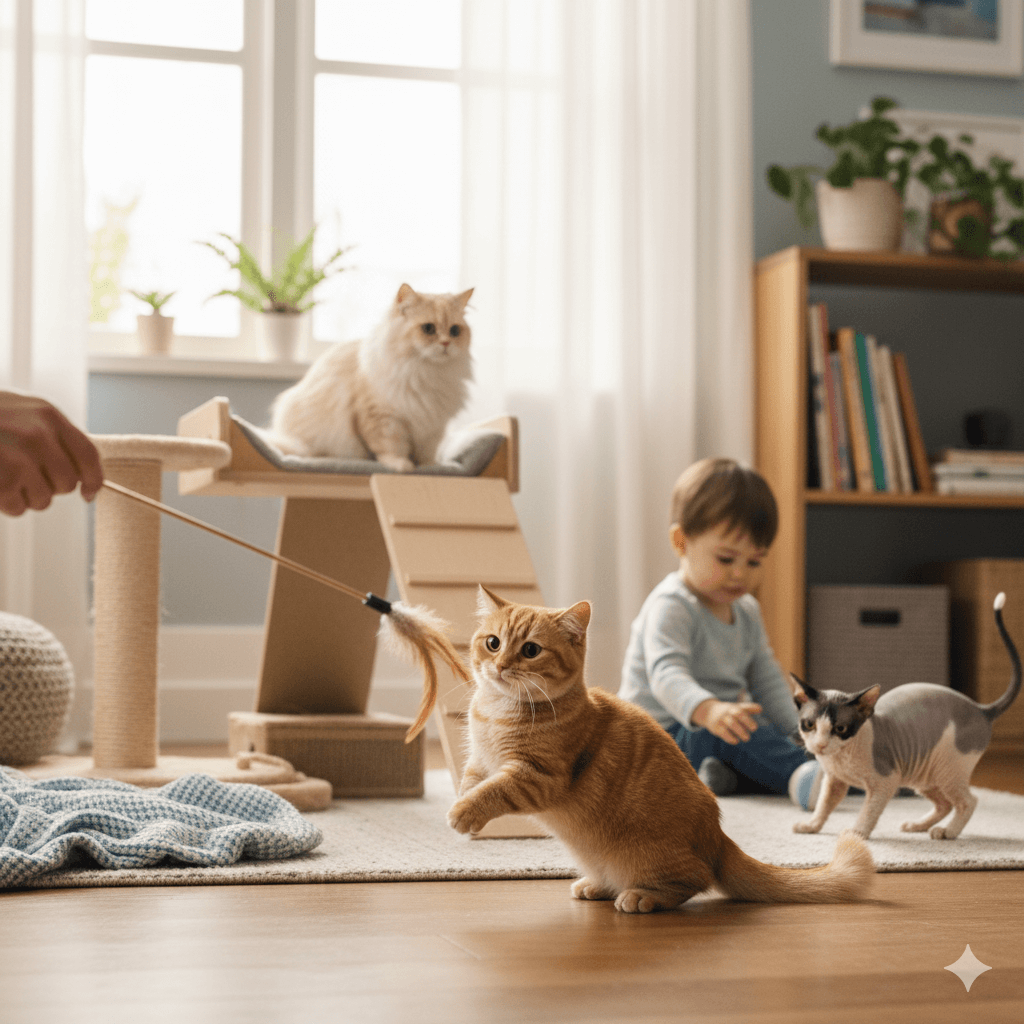
FAQ: Common Questions About Dwarf Cat Lifespan & Care
Do dwarf cats live as long as regular cats?
Yes, generally. A healthy dwarf cat from a reputable breeder, receiving proper care, can live as long as a non-dwarf domestic cat, typically between 12 to 15 years, with many living into their late teens or beyond. The dwarf gene itself is not associated with a reduced lifespan.
What is the average dwarf cat lifespan?
The average dwarf cat lifespan is typically 12 to 15 years. This range is comparable to the general life expectancy of many other domestic cat breeds and mixed breeds.
Are dwarf cats prone to more health problems that might shorten their life?
While the dwarf trait (chondrodysplasia) itself doesn’t shorten their life, it can predispose them to orthopedic issues like arthritis or patellar luxation due to their short legs. However, with good weight management, a supportive environment, and regular vet care, these issues can often be managed, allowing for a normal dwarf cat lifespan. Responsible breeding is key to minimizing other genetic health risks.
How can I help my dwarf cat live a long and healthy life?
Provide a high-quality, balanced diet to maintain an ideal weight, ensure regular veterinary check-ups, create an accessible home environment with ramps and steps, encourage gentle exercise, and offer plenty of love and mental stimulation. Spaying or neutering also contributes to a longer, healthier dwarf cat lifespan.
Do dwarf cats need special food?
Not necessarily a “special” dwarf cat food, but they do need a high-quality, nutritionally complete cat food appropriate for their age and activity level. Due to their predisposition to orthopedic issues, strict weight management is crucial, so portion control is particularly important. Your vet can recommend the best diet.
A Full and Vibrant Life Awaits Your Dwarf Cat
The journey of welcoming a dwarf cat into your home is filled with unique joys and a commitment to understanding their specific needs. While their distinctive appearance naturally leads to questions about the dwarf cat lifespan, the resounding answer is one of positivity: with dedicated care, a supportive environment, and responsible breeding, these charming felines can enjoy a life as long and fulfilling as any other cat.
By focusing on excellent nutrition, consistent veterinary attention, proactive management of potential health considerations, and creating an accessible home, you lay the foundation for years of purrs, playful antics, and unconditional love. Embrace the adventure, and your dwarf cat will undoubtedly bring immense happiness to your life.
Why Is My Cats Second Eyelid Showing? Best 7 Expert Tips! Understand causes, health signs, and how to respond when your cat’s third eyelid becomes visible.
How Do I Know If My Cat Died Peacefully? Best 7 Expert Tips! Discover the quiet signs of a peaceful feline passing and find comfort in their final moments.
Cat Allergy Eyes: Best 7 Expert Tips! Discover why your eyes react to cats and learn proven strategies for relief—without giving up your feline friend.
Why Do Abyssinian Cat Colors Matter? Best 7 Expert Tips! Discover the genetics, rare hues, and care secrets behind Abyssinian coat colors for a healthier, happier cat.

